
Gardening is one of the things I love to do when I’m not working. And my favorite plants are the ones that provide food. Why do I like sustainable gardening? Sustainable gardening has gained significant importance in our quest for a greener and more self-sufficient future. Not only do sustainable gardens contribute to environmental conservation, but they also offer a practical solution to save money through growing food at home. In this article, we will talk about the importance of sustainable gardens and how pot-grown food can help you save money while promoting sustainability.
The Significance of Sustainable Gardens
Sustainable gardens are key in promoting environmental well-being, conserving resources, and reducing our ecological footprint. By adopting eco-friendly practices, such as water conservation, organic gardening, and composting, we create harmonious ecosystems that benefit both the environment, our family and our wallets.
Pot Gardening: A Space-Saving Solution
Pot gardening offers a practical and space-saving solution for individuals with limited outdoor areas or urban dwellers. Even with just a small balcony, rooftop, or sunny window sill, you can create a thriving garden. By utilizing pots, containers, or vertical gardening techniques, you can maximize your available space and grow an array of food-bearing plants. You can even have an indoor sustainable garden as long as the plants get enough sunlight.
Plants for Pot Gardening and Food Production
When selecting plants for pot gardening, focus on varieties that are compact, well-suited for containers, and provide a plentiful harvest. Here are some examples of food-producing plants that thrive in pots:
Tomatoes:
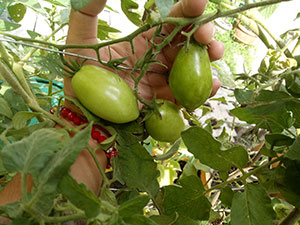
When it comes to growing tomatoes in a pot, selecting the right variety is crucial for successful container gardening. Compact or determinate tomato varieties are particularly well-suited for pots as they have a more restrained growth habit and can thrive in smaller spaces.
Choose compact or determinate varieties, such as ‘Patio Princess’ or ‘Tiny Tim,’ which yield an abundance of delicious tomatoes suitable for salads, sauces, or snacking. Or you can also try any kind of tomatoes you have like I did as you see in the picture.
Herbs
Basil, thyme, rosemary, mint, and other herbs are excellent choices for pot gardening. They require minimal space, are easy to grow, and add fresh flavors to your culinary creations. Read this post to know how to start your indoor herb garden.
Eggplant
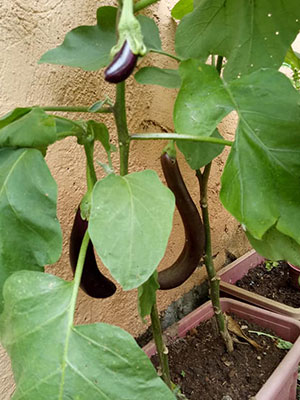
Yes! You can plant eggplant in a pot just like I did. During summer I get more eggplants than you see in the picture. Eggplant loves sunlight and also helps it to produce more.
Planting eggplant in a pot is a practical and rewarding gardening endeavor. You need to choose a large container with good drainage to accommodate the plant’s root system. Fill the pot with nutrient-rich soil and sow the eggplant seeds or transplant seedlings.
Place the pot in a sunny location and water regularly, ensuring the soil remains moist but not waterlogged. With proper care, you can enjoy the satisfaction of watching your eggplant thrive and harvest delicious, homegrown produce right from your pot.
Peppers
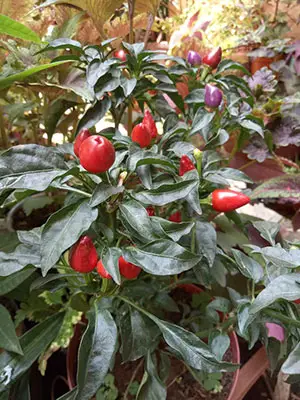
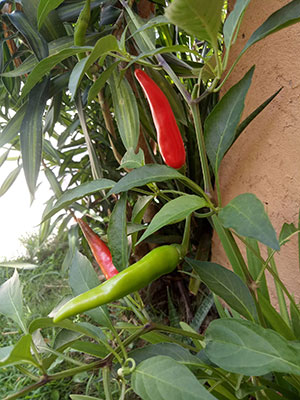
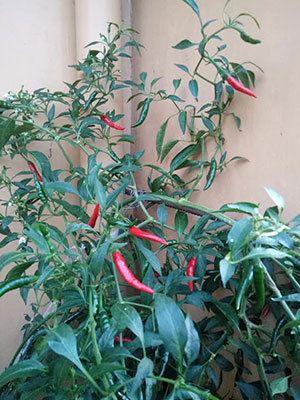
If you’re considering growing peppers in a pot, choosing compact varieties will ensure success in limited spaces. Two excellent options for pot-grown peppers are ‘Cayenne Red’ and ‘Patio Fire’. These varieties not only thrive in containers but also offer vibrant and flavorful peppers that can add a spicy kick to your culinary creations. It’s perfect for adding a spicy kick to your dishes.
Salad Greens
Leafy greens such as lettuce, spinach, and arugula are ideal for pot gardening. They grow quickly, provide a continuous supply of fresh, nutritious greens, and are perfect for salads or sandwiches.
Strawberries
These sweet delights can be grown in hanging baskets or upright pots, offering a delicious harvest right at your fingertips. Strawberries are well-suited for container gardening, making them an ideal choice for those with limited space or who want to add a touch of charm to their gardens. Hanging baskets are particularly popular for growing strawberries as they allow the plants to cascade over the sides, creating an appealing display and making harvesting even easier.
Cost Savings through Sustainable Gardening
Sustainable gardening directly contributes to significant cost savings, helping to stretch your household budget. Consider the following ways in which pot-grown food helps you save money:
Reduced Grocery Expenses
By growing your own food, you can significantly decrease your reliance on store-bought produce. This reduction in grocery expenses can be especially noticeable for organic or specialty items that tend to be more expensive. Saving on your grocery bills adds up over time and allows you to allocate your budget to other necessities.
Minimized Food Waste
With a pot garden, you can harvest only what you need, reducing the likelihood of food waste. Unlike store-bought produce that may spoil before it is consumed, you can enjoy the freshness of homegrown fruits, vegetables, and herbs while minimizing waste and saving money.
Lowered Food Costs
Homegrown produce eliminates the need for transportation, packaging, and markups associated with store-bought items. You also have control over the use of pesticides and can choose organic methods, saving money on purchasing expensive organic produce.
Year-Round Savings
By growing food in pots, you can extend your growing season by bringing plants indoors during colder months. This allows you to continue enjoying homegrown produce and avoiding the higher prices of out-of-season fruits and vegetables.
Seed Saving and Plant Propagation
Sustainable gardeners often save seeds from mature plants or propagate new plants from cuttings or divisions. This practice eliminates the need to purchase new seeds or seedlings, resulting in long-term cost savings.
Additional Financial Benefits
In addition to the direct savings on food expenses, sustainable gardening offers other financial benefits:
- Reduced Landscaping Costs: Traditional lawns require regular maintenance, including watering, mowing, and fertilizing, which can be costly. By converting part of your lawn into a sustainable garden, you can decrease your lawn maintenance expenses and conserve water resources.
- Lowered Health Expenses: Homegrown, organic produce reduces exposure to potentially harmful pesticides and chemicals, potentially leading to long-term health benefits and lower healthcare costs.
Conclusion
Sustainable gardens, particularly those utilizing pot gardening techniques, offer an accessible and cost-effective way to grow your own food. By embracing sustainable gardening practices, you not only contribute to a greener future but also enjoy substantial savings on grocery bills, reduced food waste, and minimized expenses on landscaping and health. Take the opportunity to cultivate a sustainable pot garden and savor the rewards of homegrown, delicious produce while making a positive impact on your finances and the environment.

Leave a Reply